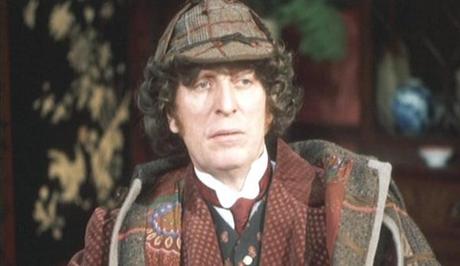Contributor: John Keegan
Written by Robert Holmes and Robert Banks Stewart
Directed by David Maloney
Rounding out the formidable Season 14 of the Classic Who era, this serial is an interesting confluence of inspirations and archetypes. There’s obviously a bit of Sherlock Holmes from the start, and not a little Pygmalion and Fu Manchu as the story unfolds. Having the Doctor uncover a mystery, and one without a telegraphed resolution, while also driving home his intention to instruct Leela in the finer points of intergalactic etiquette makes for a surprisingly strong foundation.

The central premise is a science fiction lover’s dream: a criminal madman from the 51st century uses flawed time travel technology, only to arrive in the Victorian era. Posing as Chinese legend Weng-Chiang, this madman uses young woman to fuel devices that keep him alive, as he seeks to locate his missing time travel cabinet. Wackiness ensues.
Savvy Whovians will recognize the reference to Time Agents from the 51st century, and wistfully consider the notion of Jack Harkness jumping into the fray. And Magnus Greel’s desire to break out of his society’s chains and travel through time, regardless of the cost, brings to mind a certain Time Lord. Greel even has a Companion of sorts: the creepy automaton Mr. Sin, one of the most bizarre elements of a Doctor Who story yet.
Apparently one of the intentions for Leela was to play up the whole Eliza Doolittle theme, which certainly would have been a change of pace from the Doctor/Sarah Jane dynamic. This would have even had her running about in Victorian garb, from what I understand. I’m glad it didn’t go that way, if only because Leela is a lot more fun in her current wildling form. (Though shouldn’t a “savage” know better than to hesitate when you have the element of surprise? If she stabs Greel right in the back before he knows she’s there, it’s a done deal!)
The story is stuffed with interesting diversions and plot twists, most of which are a lot more fun to discover on one’s own. One element that really helps the story work, however, is the vivid set of supporting characters. Mr. Jago and Professor Litefoot are practically legends of their own at this point; I had heard of them without even realizing the context of their introduction. They make a solid double act as the story draws towards its conclusion, so much so that one could believe that this was intended more as a backdoor pilot for their own show!
One thing that took some getting used to was the casual racism. It’s a mixture of cultural considerations of the time period being portrayed and those of the period the serial was produced. That doesn’t change the fact that it makes certain scenes and casting decisions more than a little disconcerting. It’s not unlike watching a classic James Bond film and having to accept the casual sexism that was part and parcel of the franchise; one doesn’t have to buy into the negative stereotypes and attitudes to appreciate the other concepts at play.
And of course I would be remiss if I failed to mention a moment that somehow got past the censors. At one point, Leela is wearing a thin white gown, and she’s dragged through the water in the sewers. Needless to say, when she stands up, very little is left to the imagination. Given how Leela has a reputation for delivering fan service to the “dads” during her tenure, that was hard to ignore!
This serial is a favorite for some Classic Who fans, and I think there’s good reason. I wasn’t quite as keen on it, at least compared to “Robots of Death”, but it was another solid entry and one of the better of the longer serials up to this point. Not a bad way to end the Hinchcliffe era, when all is said and done.
Writing: 2/2
Acting: 2/2
Direction: 2/2
Style: 2/4
Final Rating: 8/10

